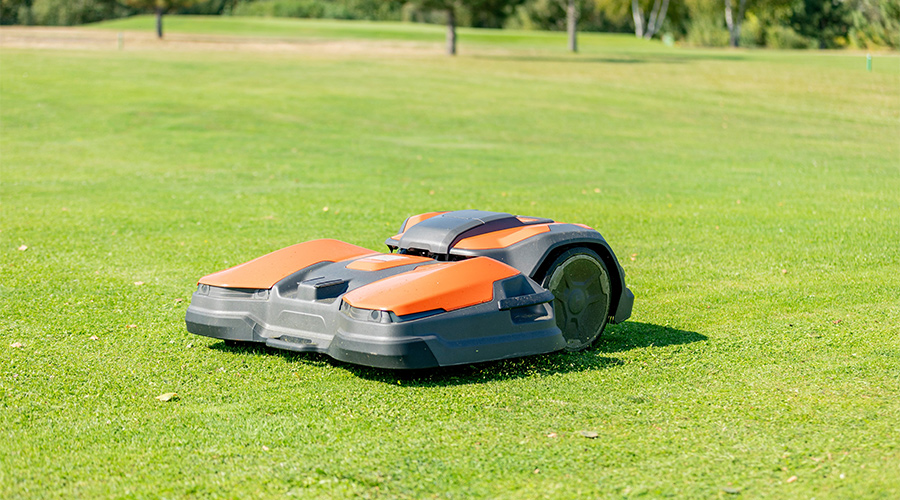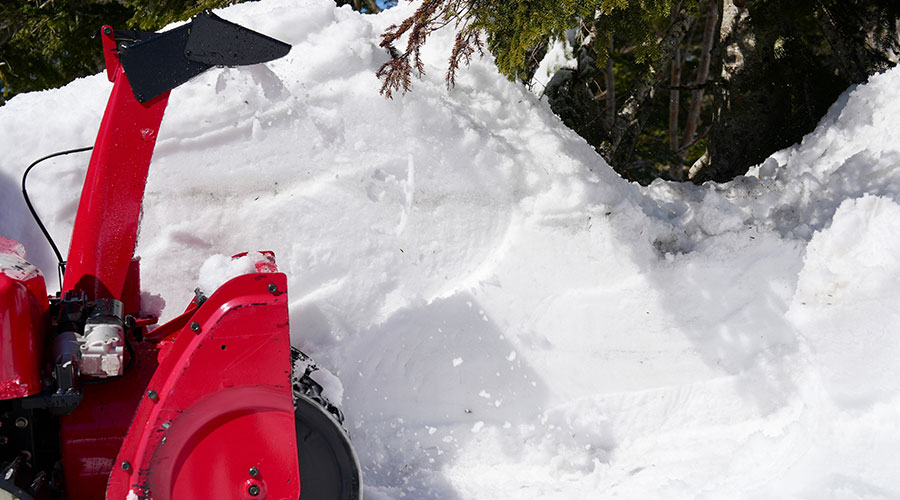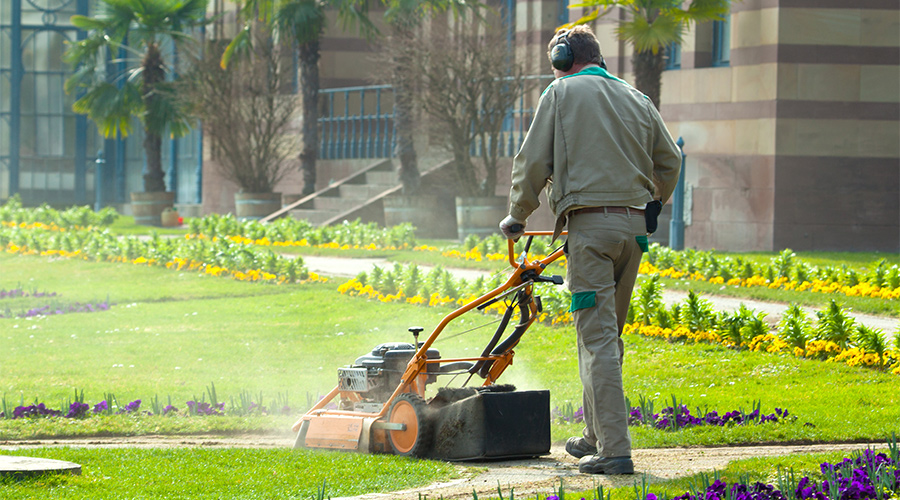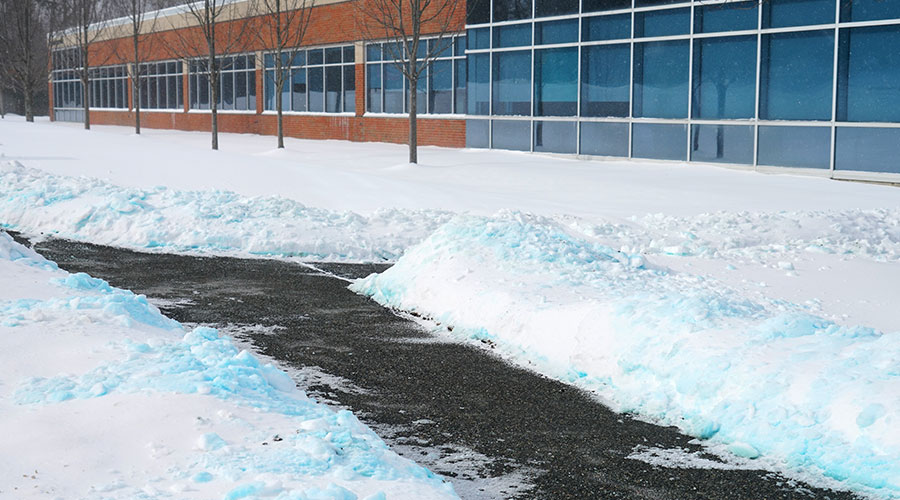Fine-Tuning Grounds Care
A range of activities, from pruning and aeration to debris pickup and chemical application, can help round out a comprehensive program
Spring has finally arrived and is in full swing. Mowers and other vehicles have been fine-tuned and are in top condition. Employees have been trained on safe, effective operation of these key pieces of equipment. But grounds care is not just mowing anymore. Successful turf and grounds management efforts go far beyond these core activities. Grounds care managers must complement these core activities with such tasks as aeration, seeding, general cleanup, mulching, pruning and fertilizing.
By reviewing staffing, scheduling and equipment considerations necessary for safe, effective and efficient completion of these tasks, managers can develop a comprehensive program that keeps landscaped areas looking their best.
Lawn Maintenance
Aeration alleviates soil compaction, aids in nutrient uptake, increases moisture penetration, helps reduce thatch, and increases gas exchange into the soil. The process also severs the roots of the grass, so other plants are stimulated into more vigorous growth. Crews should complete aeration in spring or fall when turf is actively growing.
In heavy-traffic areas, managers should schedule aeration at least twice each year to help keep grass healthy. Aeration is best completed prior to pre-emergent herbicide application, but university studies have shown that aeration does not harm pre-emergent effectiveness.
If the site is irrigated, it contains low-voltage lighting wires or other buried cables or lines. They should be located and clearly marked before aeration begins. The tines of an aerator can easily break an irrigation head or cut through a cable.
If lawn renovation is necessary, core aeration followed by overseeding is an excellent method to rejuvenate a lawn. Seeding after aeration allows the seed to go deeper into the soil, where there is more moisture and it is less likely to dry out after germination. Slit seeding is also an accepted method of renovation, but the seed is not placed as deeply into the soil and dries out more readily.
Topdressing sports fields and fine lawn areas with compost, sand/soil mixes, or other soil amendments is beneficial to improving playing fields and overall quality of turf, especially in areas of heavy compaction or in clay or other poor soils. Frequent topdressing has been common in golf course management for years.
Some sports field managers now topdress fields up to eight times per year. For fine lawns, topdressing is best done in spring and fall. Topdressing just after aeration allows the soil amendment to get further into the soil and blend with the existing soil instead of just lying on top.
Bed Cleanup
Backpack blowers and vacuums can efficiently remove leaves and debris from beds. Using a blower in the middle of beds to get debris out from under shrubbery and following with a vacuum or shredder is a time-saving process. Once beds are free of debris, maintaining crisp bed and tree ring edges keeps the lawn and landscape looking top-notch. This activity can really make a property stand out.
Edgers have evolved over the years. Managers should specify edgers that are light and compact and that offer versatility in cutting depth and width, easy maneuverability to create smooth curves, and a durable and powerful cutting blade to get through heavy soils.
Bed edging is most efficient if done after debris clean up and before mulching. The loose soil that is generated by the bed edger can be spread throughout the bed or removed. Then the new mulch can be placed in the bed.
Crews should not pile the loose soil or mulch around the base of trees or shrubs. This practice can damage the trunks and shorten plant life.
Pruning
Managers should schedule tree and shrub pruning when plants are not in an active growing stage. Winter is an excellent time to complete most pruning chores because it is less stressful on the plant, branches are easily seen, and it is a productive use of a relatively slow time for the grounds crew.
Crews also can complete horticultural pruning and trimming during summer months. As a general rule, prune spring flowering plants just after they flower, and prune summer flowering shrubs in early spring before they break bud. Do not continue pruning in late summer and early fall. Pruning stimulates new growth. New growth coming on in fall and early winter is subject to winter kill.
Bypass-type hand pruners, lopers, handheld saws, gas-powered hedge shears, pole pruners and chain saws are all necessary tools for proper pruning. Keeping blades sharp at all time will greatly increase efficiency and allow cut surfaces to heal faster, reducing chance of disease or insect invading the wound.
Line trimmers are now multi-tasking tools. Attachments available include hedge trimmers, power scythes, mini-cultivators, lawn edgers, power brooms, and pole pruners. Of course, there is still the line trimmer as well as a variety of steel brush-cutting blades for clearing small trees and brush and heavy weeds. These multi-task tools can be cost-effective pieces of equipment.
When looking at the line trimmers and brush clearing saws, managers should consider shoulder harnesses, which help distribute the weight of the line trimmers and brush-clearing saws to reduce operator fatigue. A double shoulder harness is required by ANSI for operators using a circular saw blade on a clearing saw.
Fertilizer and Chemical Application
Hooded or skirted spray equipment can make weed-control applications more efficient and safer. Walk-behind, or pull-behind or attachable boom sprayers with a skirt that reaches the ground keeps drift to a minimum. They can be especially beneficial for spraying when the wind is too strong for a conventional sprayer, as well as for spraying around sensitive landscape.
Ride-on sprayers and spreaders are dedicated units for chemical application that allow an applicator to ride instead of walk, cutting application time and operator fatigue. Operators can apply liquid and dry chemicals at the same time, also a great time saver.
The ability to drive at a consistent speed results in more consistent application rate. They are compact and can get through small gates and are relatively lightweight compared to a riding mower unit or utility vehicle with a sprayer or spreader attached.
Personal Protection
Pruning and mulching, two of the most seemingly safe tasks, are common injury producers. Cutting fingers with pruners, sticks in the eye, thorns in the skin and mulch and dust in the eyes are common problems. Hearing loss due to constant exposure to loud noise also is increasing.
Chain-saw safety is often overlooked in grounds maintenance. Because a chain saw is not used often or for a very long time, workers become lax. Managers should require all chain-saw users to wear chaps and thick, leather or cut- resistant gloves when using a chain saw, even when cutting just one branch.
Steel-toed boots are also an important personal safety item for most grounds-care activities, and rubber boots are a must for chemical applicators.
Providing colored clothing — safety orange and safety green — is a great way to promote safety every day. Increasing worker visibility can reduce accidents, and wearing bright safety clothing is a constant reminder to choose safe working practices. Managers have a variety of clothing from which to choose: hats, T-shirts, jackets, coveralls, gloves, chaps now readily available. Check OSHA regulations for specifics clothing requirements.
Equipment Safety Dos and Don’ts
-
DO make sure operators use daily equipment safety checklists. Before any piece of equipment is taken out, the operator should check it to make sure it is in proper working order. Workers should know that just because the equipment worked fine yesterday doesn’t mean it is still working fine today.
-
DON’T allow employees to override safety features on equipment. It is not uncommon to see safety guards taken off weed eaters and shut-off handles taped up on mowers. These features were put on equipment for a reason. Just like the safety stickers on equipment warning users of dangers, the safety features were not put on equipment because someone thinks injury might occur. Injuries already have happened.
-
DO teach safe operations to each employee. All employees should be trained. Even experienced staff should completed safety training each year. Training might consist of hands-on instruction and watching safety videos. Many manufacturers provide videos with their equipment. When departments get a new piece of equipment, they should bring in the sales representative to walk through proper operating procedures with the staff.
-
DON’T allow employees to work in unsafe conditions. Because much of the work to be done is outside, weather plays a big role in our schedules and safety. Mowing sloping ground with wet grass, working outside in a thunderstorm or spraying pesticides on a windy day are not safe practices.
-
DON’T allow employees to operate mowers or weed eaters when people are nearby. Serious accidents have occurred when objects are thrown from the blade of the mower or weed eater. Spraying chemicals also is best done where there are no pedestrians or cars in the vacinity.
-
DO provide and require employees to wear personal safety gear at all times. Providing and requiring proper safety gear is extremely important to insuring safety in grounds care. Ear and eye protection are two of the most underused safety products. Eye injuries are the most common type of on the job injury.
-
DO always handle, use, and store pesticides appropriately. Always read and follow label directions and state requirements. Make sure all employees are informed of the right-to-know laws and know the location of material safety data sheets.
-
DON’T put productivity ahead of safety. Do not rush to get a job done if it means working in an unsafe manner.
All the training, checklists and certifications don’t mean much if the employee still doesn’t follow proper procedures. Just after an incident everyone is aware of and follows safety procedures; however after a few weeks they become lax again.
Responsible managers must continually but not constantly observe, get out in the field and check to make sure workers follow safety procedures. If they don’t, managers should take action. Don’t wait for an incident to occur to start watching people.
-
DO get all employees involved. Take a positive approach to safety, scheduling and efficient use of all tools used to maintain an attractive, healthy landscape. Get employees involved in choosing equipment, setting schedules and training each other.
Involved employees take ownership and pride in their work. Safety, productivity and the appearance of the grounds will automatically improve.
|
Related Topics:











